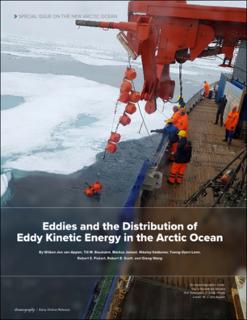| dc.contributor.author | von Appen, Wilken-Jon | |
| dc.contributor.author | Baumann, Till Martin | |
| dc.contributor.author | Janout, Markus | |
| dc.contributor.author | Koldunov, Nicolay | |
| dc.contributor.author | Lenn, Yueng-Djern | |
| dc.contributor.author | Pickart, R.S. | |
| dc.contributor.author | Scott, Robert B. | |
| dc.contributor.author | Wang, Qiang | |
| dc.date.accessioned | 2022-06-08T12:37:32Z | |
| dc.date.available | 2022-06-08T12:37:32Z | |
| dc.date.created | 2022-05-02T10:58:33Z | |
| dc.date.issued | 2022 | |
| dc.identifier.issn | 1042-8275 | |
| dc.identifier.uri | https://hdl.handle.net/11250/2997939 | |
| dc.description.abstract | Mesoscale eddies are important to many aspects of the dynamics of the Arctic Ocean. Among others, they maintain the halocline and interact with the Atlantic Water circumpolar boundary current through lateral eddy fluxes and shelf-basin exchanges. Mesoscale eddies are also important for transporting biological material and for modifying sea ice distribution. Here, we review what is known about eddies and their impacts in the Arctic Ocean in the context of rapid climate change. Eddy kinetic energy (EKE) is a proxy for mesoscale variability in the ocean due to eddies. We present the first quantification of EKE from moored observations across the entire Arctic Ocean and compare those results to output from an eddy resolving numerical model. We show that EKE is largest in the northern Nordic Seas/Fram Strait and it is also elevated along the shelf break of the Arctic Circumpolar Boundary Current, especially in the Beaufort Sea. In the central basins, EKE is 100–1,000 times lower. Generally, EKE is stronger when sea ice concentration is low versus times of dense ice cover. As sea ice declines, we anticipate that areas in the Arctic Ocean where conditions typical of the North Atlantic and North Pacific prevail will increase. We conclude that the future Arctic Ocean will feature more energetic mesoscale variability. | en_US |
| dc.language.iso | eng | en_US |
| dc.publisher | The Oceanography Society | en_US |
| dc.rights | Navngivelse 4.0 Internasjonal | * |
| dc.rights.uri | http://creativecommons.org/licenses/by/4.0/deed.no | * |
| dc.title | Eddies and the Distribution of Eddy Kinetic Energy in the Arctic Ocean | en_US |
| dc.type | Journal article | en_US |
| dc.type | Peer reviewed | en_US |
| dc.description.version | publishedVersion | en_US |
| cristin.ispublished | true | |
| cristin.fulltext | original | |
| cristin.qualitycode | 1 | |
| dc.identifier.doi | 10.5670/oceanog.2022.122 | |
| dc.identifier.cristin | 2020542 | |
| dc.source.journal | Oceanography | en_US |
| dc.identifier.citation | Oceanography. 2022, 35 (2). | en_US |
| dc.source.volume | 35 | en_US |
| dc.source.issue | 2 | en_US |

